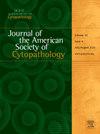Revisiting an old technique: rehydration of air-dried slides is a viable technique for Pap-stained fine needle aspiration slides for novel situations
Q2 Medicine
Journal of the American Society of Cytopathology
Pub Date : 2025-03-17
DOI:10.1016/j.jasc.2025.03.002
引用次数: 0
Abstract
Introduction
Traditional Pap staining procedure involves immediate ethanol-fixation of prepared smears. When our department absorbed cytopathology services of an affiliate hospital using nonspecialized assistants, we had problems with poorly fixed slides. We evaluated an alternative approach of rehydration of air-dried slides in comparison to both immediate and delayed alcohol fixation for Pap staining.
Materials and methods
Fine needle aspirations were performed on deidentified unfixed autopsy tissue. Sampled tissues included lung, liver, thyroid, breast, and a mediastinal mass. Paired aspirate smears were immediately fixed, air-dried and rehydrated before staining, or delayed fixation after a 5-minute air dry (DF). Additional smears were Diff-Quik stained for comparison. Slides were Pap-stained at 0 days, 1 day, 3 days, or 5 days postaspiration and numerically scored for cytomorphologic feature quality. Data were compared with one-way analysis of variance analysis.
Results
We evaluated 237 pairs of smears. The immediately fixed and air-dried groups displayed higher quality for nuclear borders, nuclear detail, distinct cell borders, and cytoplasmic staining at every time point (all P values <0.05) compared to the DF group. Rehydration did not reverse the air-dry artifact from delayed fixation in the DF group.
Conclusions
Air-drying with delayed rehydration/alcohol fixation maintains diagnostic quality in settings for which traditional preparative techniques are not optimal, technical assistance is limited, and transport is problematic. Our series demonstrates that air-dried slides maintained high quality when processed up to 5 days postaspiration. We demonstrate a technique that improves pathology outreach by providing better quality diagnostic material with minimal additional personnel costs.
重温一项古老的技术:风干切片的再水化是在新情况下处理巴氏染色细针穿刺切片的一项可行技术。
简介:传统的巴氏涂片染色程序包括立即用乙醇固定所制备的涂片。当我们科室吸收了附属医院的细胞病理学服务,使用非专业助理时,我们遇到了固定不良的问题。我们评估了风干载玻片补液的替代方法,与Pap染色的即时和延迟酒精固定相比较。材料和方法:对未确定的尸检组织进行细针穿刺。样本组织包括肺、肝、甲状腺、乳腺和纵隔肿块。配对的抽吸涂片在染色前立即固定,风干并再水化,或在5分钟风干(DF)后延迟固定。其他涂片进行diff - quick染色进行比较。在抽吸后0天、1天、3天或5天对载玻片进行pap染色,并对细胞形态学特征质量进行数字评分。资料比较采用单因素方差分析。结果:我们评估了237对涂片。立即固定和风干组在每个时间点的核边界、细胞核细节、清晰的细胞边界和细胞质染色方面显示出更高的质量(所有P值)。结论:在传统制备技术不理想、技术援助有限、运输有问题的情况下,风干加延迟补液/酒精固定可保持诊断质量。我们的研究表明,在抽吸后5天内,风干的载玻片仍能保持高质量。我们展示了一种技术,通过提供更高质量的诊断材料,以最小的额外人员成本提高病理外展。
本文章由计算机程序翻译,如有差异,请以英文原文为准。
求助全文
约1分钟内获得全文
求助全文
来源期刊

Journal of the American Society of Cytopathology
Medicine-Pathology and Forensic Medicine
CiteScore
4.30
自引率
0.00%
发文量
226
审稿时长
40 days
 求助内容:
求助内容: 应助结果提醒方式:
应助结果提醒方式:


